
Nephrops norvegicus

Nephrops norvegicus, known variously as the Norway lobster, Dublin Bay prawn, langoustine (compare langostino) or scampi, is a slim, orange-pink lobster which grows up to 25 cm (10 in) long, and is 'the most important commercial crustacean in Europe'. It is now the only extant species in the genus Nephrops, after several other species were moved to the closely related genus Metanephrops. It lives in the north-eastern Atlantic Ocean, and parts of the Mediterranean Sea, but is absent from the Baltic Sea and Black Sea. Adults emerge from their burrows at night to feed on worms and fish. Nephrops norvegicus has the typical body shape of a lobster, albeit narrower than the large genus Homarus. It is pale orange in colour, and grows to a typical length of 18–20 centimetres (7–8 in), or exceptionally 25 cm (10 in) long, including the tail and claws. A carapace covers the animal's cephalothorax, while the abdomen is long and segmented, ending in a broad tail fan. The first three pairs of legs bear claws, of which the first are greatly elongated and bear ridges of spines. Of the two pairs of antennae, the second is the longer and thinner. There is a long, spinous rostrum, and the compound eyes are kidney-shaped, providing the name of the genus, from the Greek roots νεφρός (nephros, 'kidney') and ops ('eye'). Nephrops norvegicus is found in the north-eastern Atlantic Ocean and North Sea as far north as Iceland and northern Norway, and south to Portugal. It is not common in the Mediterranean Sea except in the Adriatic Sea, notably the north Adriatic. It is absent from both the Black Sea and the Baltic Sea. Due to its ecological demands for particular sediments, N. norvegicus has a very patchy distribution, and is divided into over 30 populations. These populations are separated by inhospitable terrain, and adults rarely travel distances greater than a few hundred metres. Nephrops norvegicus adults prefer to inhabit muddy seabed sediments, with more than 40 percent silt and clay. Their burrows are semi-permanent, and vary in structure and size. Typical burrows are 20 to 30 centimetres (8 to 12 in) deep, with a distance of 50 to 80 centimetres (20 to 31 in) between the front and back entrances. Norway lobsters spend most of their time either lying in their burrows or by the entrance, only leaving their shelters to forage or mate. Nephrops norvegicus is a scavenger and predator that makes short foraging excursions, mainly during periods of subdued light. They feed on active prey, including worms and fish, which they capture with their chelipeds and walking legs, and food is conveyed to the mouth using the anterior walking legs, assisted by the maxillipeds. There is evidence that Nephrops norvegicus is a major eater of jellyfish. Nephrops norvegicus is the host to a number of parasites and symbionts. A number of sessile organisms attach to the exoskeleton of N. norvegicus, including the barnacle Balanus crenatus and the foraminiferan Cyclogyra, but overall Nephrops suffers fewer infestations of such epibionts than other decapod crustaceans do. In December 1995, the commensal Symbion pandora was discovered attached to the mouthparts of Nephrops norvegicus, and was found to be the first member of a new phylum, Cycliophora, a finding described by Simon Conway Morris as 'the zoological highlight of the decade'. S. pandora has been found in many populations of N. norvegicus, both in the north Atlantic and in the Mediterranean Sea. Individuals may be found on most segments of the lobster's mouthparts, but are generally concentrated on the central parts of the larger mouthparts, from the mandible to the third maxilliped. The most significant parasite of N. norvegicus is a dinoflagellate of the genus Hematodinium, which has caused epidemic infection in fished populations of N. norvegicus since the 1980s. Hematodinium is a genus that contains major pathogens of a wide variety of decapod crustaceans, although its internal taxonomy is poorly resolved. The species which attacks N. norvegicus causes a syndrome originally described as 'post-moult syndrome', in which the carapace turns opaque and becomes highly pigmented, the haemolymph becomes milky white, and the animal appears moribund. Other parasites of N. norvegicus include the gregarine protozoan Porospora nephropis, the trematode Stichocotyle nephropis and the polychaete Histriobdella homari.
